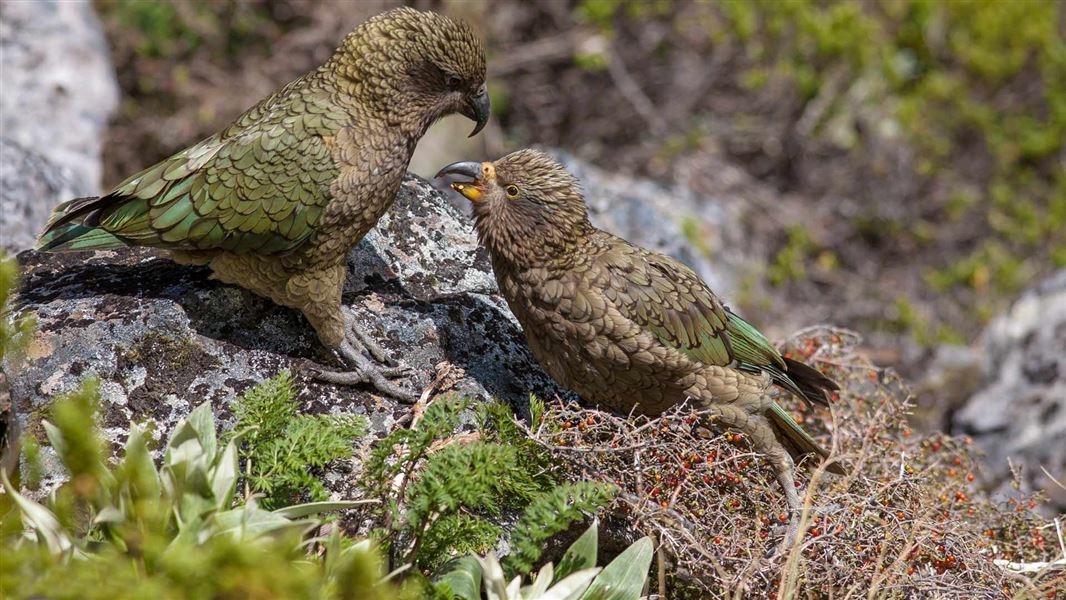By Nicola Davis and Eleanor Ainge Roy, The Guardian, March 3, 2020
 |
| The endangered kea is the world’s only alpine parrot, and one of the most intelligent birds. They show no fear of humans and have a reputation for being thieves and pranksters. |
Some parrots weigh up probabilities to help them make choices, researchers have found, in a study that provides the first evidence of this skill outside great apes.
Among previous studies, African grey parrots have been found to selflessly help their peers complete tasks and seem able to identify colours and count. Cockatoos meanwhile can keep track of an object’s location – even when it is hidden – and have been found to invent dance moves.
Now researchers have found kea, an endangered species from New Zealand and the world’s only alpine parrot, appear to use probabilities when taking a gamble.
While there have been hints that some other birds and certain monkeys may be able to do this, the team behind the new study say it is the first time this skill has clearly been shown outside of humans and other great apes.
What’s more, it seems the birds harness multiple sources of information to decide which choice is a better bet.
“There is good evidence that human intelligence is domain-general, meaning that humans can combine information of different types – social, physical [and] numerical – to make a single judgment or decision,” said Amalia Bastos, co-author of the research at the University of Auckland.But, she added, it wasn’t previously clear if other animals, besides great apes did this – or were restricted to using a single source of information at a time, meaning they are only good at solving one sort of problem.
The team add that with birds and humans having last shared a common ancestor more than 300 million years ago, it seems domain-general thinking may have arisen more than once.
“It was not a one-off quirk of evolution,” said Bastos. “Birds and other animals may be thinking in more flexible and general ways than we thought.”
The study, published in the journal Nature Communications, reveals how the team trained six male kea to associate black wooden tokens with tasty treats and orange tokens with no reward.
Among the birds involved were Blofeld, Loki and Taz – named for their reputations. “ Most of our birds are named after villains,” said Bastos, adding that Moriarty and Megatron were not involved in the current study.
Each bird was then placed in front of a researcher and two transparent jars filled with black and orange tokens.
In the first experiment, the two jars contained the same overall number of tokens, but one was largely crammed with black tokens while the other was dominated by orange.
Each bird was tested 20 times on which jar they preferred the researcher to have taken a token from. Overall three birds showed a clear preference – all favouring the jar with more black tokens.
Among further tests, both jars were filled with the same number of black tokens but a different number of orange tokens. This time four birds showed a clear preference – all favouring the jar with the greater ratio of black to orange tokens.
That, said Bastos, shows the birds are not simply responding to the actual number of black or orange tokens.
“Kea must have used proportion of black-to-orange tokens, meaning that they considered the relative likelihood, or probability, of obtaining a black token from both jars to make their choice,” she said.
Crucially, further experiments involving jars with dividers, and researchers who showed a bias for picking black tokens, revealed that the birds could make use of such considerations to boost their chances of scooping their quarry.
“This shows that at least one parrot – the kea – shows intelligence that is flexible, or gfeneral, in a way that is comparable to human or chimpanzee intelligence,” said Bastos, adding some grasp of probabilities may offer myriad benefits in the wild. “ For example, figuring out the likelihood that fruits on a tree might be ripe, could benefit from this kind of thinking,” she said.
The researchers say it is crucial that the animals, of which there are an estimated 1,000-5,000 in the wild, are saved from extinction and their intellectual capabilities further analysed.
Alex Taylor, also of the University of Auckland and a co-author of the paper, said the findings had implications not only for biological intelligence but potentially also for artificial intelligence.
“One of the holy grails of research on artificial intelligence is the type of commonsense reasoning that humans show, where we bring together multiple sources of information into a single prediction or judgement about what will happen next in the world,” he said. “Our work suggests that aspects of this ability have likely evolved twice on our planet – in primates and birds.”
Dr Manon Schweinfurth, an expert in animal behaviour from the University of St Andrews, who was not involved in the work, said the findings push back against the idea that animals have only become “clever” at tasks they need for their particular role – for example, a squirrel remembering where it buried its nuts.
“Kea seem to be able to integrate several [types of] information and that suggests that they are not ‘clever’ only in one specific aspect but also in others,” she said. “That might suggest that intelligence may have evolved as one package, not as several smaller packages.”
No comments:
Post a Comment